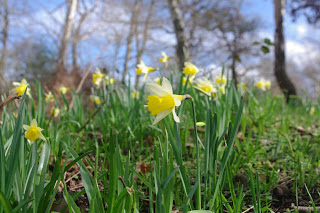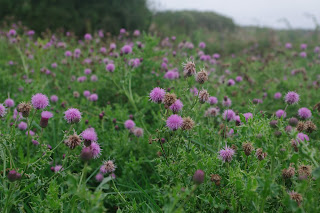A diary of back garden botany, urban ecology, rural rambles and field trips to the middle of nowhere...
Friday, 28 September 2018
A calendar of wildflowers: as summer turns to autumn the wildflower season draws to a close. I thought I'd trawl through the archives for a compilation of some of our common and uncommon wildflowers through the year.
Snowdrops (Galanthus nivalis) are one of the first to show their heads in late winter from February onward into March.
Primroses (Primula vulgaris) are prolific in early spring in both town and country. Wild Daffodils (Narcissus pseudonarcissus) are abundant in some parts of the country though absent in others. Cowslips (Primula veris) can form large colonies in grasslands and pastures that have not been lost to modern farming methods.
Some wildflowers have particularly specific habitats and often these are the very habitats that have been diminished over decades.
Pasque Flowers (Pulsatilla vulgaris) occur in a handful of places around Eastertime in England on sloping unploughed chalk and limestone grassland.
Snake's-head Fritillaries (Fritillaria meleagris) require meadows that flood in winter to flourish whereas Summer Snowflakes sometimes called Loddon Lillies (Leujocum aestivum) require permanently marshy habitats on the margins of rivers. The river Loddon is indeed its most substantial location though curiously it isn't present in similar conditions elsewhere.
Spring is the season for woodland wildflowers like Wood Anemones (Anemone nemerosa), Bluebells (Hyacinthoides non-scripta) and Ramsons (Allium ursinum). They like the shade of deciduous woodland but take advantage of the extra light to flower before the leaves fill out the canopy.
So too the flowers of the hedgerow come forth in spring like Greater Stichwort (Stellaria holostea) and Hedge Woundwort (Stachys sylvatica).
Orchids are in a class of their own. There are orchids that flower early, orchids that flower late, some in the shade, some in the sun. Some like it dry, some like it marshy. Certain plants are generalists but orchids are highly specialised in their adaptations to very specific niches.
I think the ones above are pink and white forms of the Common Spotted Orchid (Dactylorhiza fuchsii) which aren't very common anymore. Indeed many of the 56 varieties of orchid that grow in the UK are rarities and some are on the verge of extinction.
Many wildflowers favour open ground. In fact Foxgloves (Digitalis purpurea) also do fine in semi-shady woodland glades and hedgebanks but Meadow Cransebill (Geranium pratense) likes plenty of mid-summer sun.
Meadowsweet (Filipendula ulmaria) and Purple Loosestrife (Lythrum salicaria) are also sun lovers but need plenty of moisture. The former is a plant of marshy meadows, the latter of riverbanks and ditches.
In the lazy, hazy daze of high summer Field Scabious (Knautia arvensis), Ox-eye Daises (Leucnathemum vulgare) and Knapweeds (Centaurea species) illuminate traditionally farmed meadows and other grasslands.
As summer progresses peak flowering starts to wane but coastal wildlflowers persist. Viper's Bugloss (Echium vulgare) grows near the coast. Sea Lavender (Limonium vulgare) carpets muddy salt marshes and Sea Mayweed (Tripleurospermum inodorum) grows among the shingle of stony beaches.
By the end of September most plants that are native or naturalised in the UK have flowered but their foliage may remain as a reminder of their presence. Or in some cases their seed heads may be just as striking as their flowers like these Teasels (Dipascus fullonum).
Tuesday, 25 September 2018
Sunday, 23 September 2018
Toxic plant! Several weeks ago I visited my brother in Hastings. He drew my attention to a mystery plant in his garden. Neither of us had seen such a plant before and it was not something he had planted so it must have self-seeded. He did some research and identified it as The Devil's Trumpet aka Jimson Weed aka Thorn Apple (Daturia stramonium).
I didn't have a camera with me at the time so I've asked him to send me some pics (above). It's taller by now and the numerous rather lovely flowers have faded; there is still one of the pale blue trumpet-like flowers visible towards the bottom of the top photo. The others have turned into prickly fruit type seed heads. But these fruits are not for eating, nor any part of the plant.
D. stramonium originates from North America or possibly Mexico but by whatever the means of travel there are reports of it growing in diverse parts of the world (in this case the seaside in southern England!). Various botanical sources quote the following account written by one Robert Beverly in 1705. It describes an incident in Jamestown, Virginia in 1679 when a group of soldiers thought the plant's leaves could be used as a vegetable:
"Some of them eat plentifully of it, the Effect of which was a very pleasant Comedy; for they turn'd natural Fools upon it for several Days. One would blow up a Feather in the Air; another wou'd dart Straws at it with much Fury; another, stark naked, was sitting in a Corner, like a Monkey, grinning and making Mows at them; a Fourth would fondly kiss and paw his Companions and snear in their Faces, with a Countenance more antick than any Dutch Droll... Indeed, they were not very cleanly; for they would have wallow'd in their own Excrement, if they had not been prevented. A thousand such simple Tricks they play'd, and after Eleven Days, return'd to themselves again, not remembering anything that had pass'd".
'Scuse me while I kiss the sky. Joking aside it's a moot point whether ingesting this plant would be a "very pleasant Comedy" or a pretty bad trip so all in all not one for the salad bowl!
Saturday, 22 September 2018
Ivy (Hedera helix) is a wildflower and wasps are pollinators, though both are somewhat undervalued. We probably wouldn't display Ivy in a vase for example but it is indeed a flowering plant. Similarly wasps are not held in the same esteem as bees but play a major role as pollinators.
I saw a dense wall of H. helix this week and it was swarming with wasps; probably the Common Wasp (Vespa vulgaris).
Ivy provides the last major source of forage in the year for pollinators. In Dorset one year I noticed many Red Admirals feeding on it. On another rural ramble I recall a long country lane thick with Ivy on both sides and swarming with honey bees. The hum was so loud that at first I thought some piece of machinery was in operation nearby. It must have taken tens of thousands of bees to generate that sound.
Thursday, 20 September 2018
Himalayan Balsam (Impatiens glandulifera) has a bad rep among ecologists but it wasn't born to be bad; I think it might just be misunderstood.
It does indeed hail from the Himalayas and was introduced to British gardens by the Victorians who loved finding exotic specimens. I. glandulifera (also known as Giant Balsam) is a very fast growing annual, up to 10 feet tall. It seeds itself by exploding pods propelling seeds up to 10 or 12 yards away. Therein lies the perceived problem: it quickly jumped the garden fence into the countryside where it has naturalised and can be prolific. It favours water courses and spreads along them; the seed dispersal is no doubt aided by the current.
Ecologists fear that it displaces native vegetation and conservation groups often include a day of "balsam bashing" in their calendar of events. But I like this triffid of a plant. Drifts of it really are very pretty and it grows through dense vegetation like bracken where other wildflowers cannot. It flowers late in the summer providing a timely hit of nectar for the bumblebees.
The photos above were taken last week in Dorset of a stand which has been there for as long as I can remember. It doesn't seem to be destroying the local habitat. It certainly has spread along the River Lym from this colony but seems to coexist quite happily with the native ferns, Ramsons, Bluebells et al. Where the river flows through Lyme Regis the Balsams grow alongside other "foreign" garden escapes like Buddleia (Chinese), Red Valerian (Mediterranean) and Mexican Daisy. The combination makes for a very attractive display.
Monday, 17 September 2018
There were still wildflowers to be seen along the South West Coast Path when I hiked from Weymouth to Lyme Regis last week. Common Fleabane (Pulicaria dysenterica) was prolific with masses of cheery yellow flowers.
Patches of Heather (Erica species) and Gorse (Ulex europaeus) are frequent on the slopes and plains. The photo of the Gorse was taken when I was walking through low cloud in the hills above Abbotsbury- it looks more like the Scottish Highlands than Dorset!
The shingle of the Chesil Beach is a harsh environment but nonetheless supports colonies of coastal wildflowers such as Sea Mayweed aka Sea Chamomile (Tripleurospermum maritum), Yellow Horned Poppy (Glaucium flavum) and Sea Kale (Crambe maritima).
On a smaller scale there are little gems like Thrift (Armeria maritima) and Sea Campion (Silene uniflora).
I noticed Water Mint (Mentha aquatica) was frequent in ditches and sumps where the fields drained down to the shore.
Hemp Agrimony (Eupatorium cannabinum) is another plant that favours ditches and damp places. It's coming to the end of its flowering period but where it persists the raggy flower heads were still attracting the bumblebees.
Various common wildflowers of the countryside were to be seen here and there, for example Wild Marjoram (Origanum vulgare), Red Campion (Silene dioica) and Yellow Toadflax (Linaria vulgaris).
To my eye wildflowers are at their most enchanting when they form drifts of colour across the landscape. Shown above: the aforementioned Fleabane and Dwarf Thistle (Cirsium acuale).
Subscribe to:
Posts (Atom)





















































